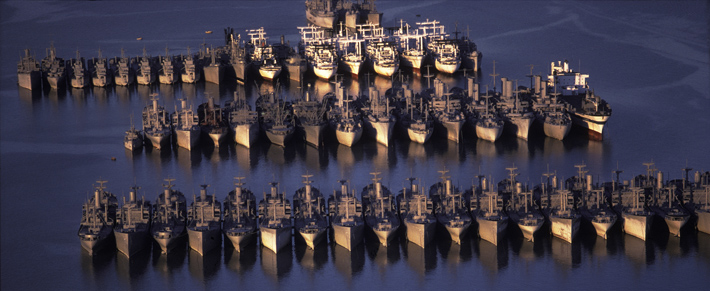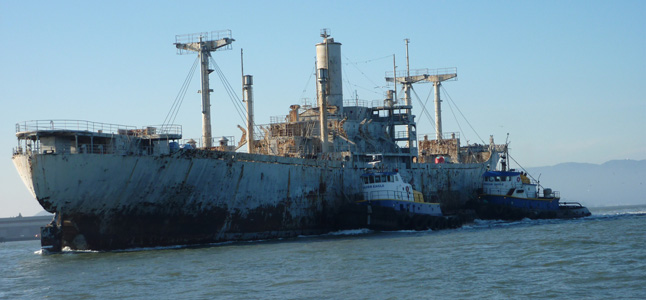Due to the efforts of San Francisco Baykeeper, Arc Ecology, and the Natural Resources Defense Council (NRDC), the decaying, toxic vessels of the Ghost Fleet will soon haunt the waters of Suisun Bay no longer.

Within the next two years, all of the ships have to go through a thorough initial hull cleaning at a local dry dock, where toxic, peeling paint and invasive species can be captured. Photo courtesy of Baykeeper.
By Deb Self and Saul Bloom
Published: July, 2010
Due to the efforts of San Francisco Baykeeper, Arc Ecology, and the Natural Resources Defense Council (NRDC), the decaying, toxic vessels of the Ghost Fleet will soon haunt the waters of Suisun Bay no longer. In an important victory for the health of San Francisco Bay and for the diverse range of animals that thrives in the unique habitat of Suisun Bay, we have successfully secured an effective cleanup plan for the Ghost Fleet.
Earlier this year, NRDC, Arc Ecology, and San Francisco Baykeeper settled a lengthy lawsuit against the U.S. Maritime Administration to clean up the aging toxic vessels moored in Suisun Bay near Benicia. Under the agreement, the federal agency will be required to remove the loose and peeling paint from the vessels’ exteriors this year, and then permanently remove the ships for disposal within seven years, starting with the most environmentally unsafe ships.
Located in northern San Francisco Bay near the Sacramento-San Joaquin Delta, Suisun Bay is vital habitat for several species of endangered fish, including Chinook salmon and Delta smelt. Hundreds of native birds live in the marshy areas of Suisun Bay, and it is in an important winter stopover on the Pacific Flyway, along which thousands of birds migrate during the fall and spring.
Toxic Impacts
The 52 decrepit vessels in the Ghost Fleet were decommissioned and placed in “storage” in Suisun Bay after World War II and the Korean War with the idea that they could be reactivated for wartime use. Many of the vessels are no longer seaworthy, however, and water must be pumped from them regularly to keep them afloat. They are now deteriorating and leaching toxic paint, heavy metals, fuel and other pollution into the water and sediment. An estimated 20 tons of heavy metals—including lead, zinc, copper and cadmium—have already fallen, blown or washed off the ships into the water, according to the agency’s own analysis. In fact, experts estimate that if the ships were to remain in the water, they would dump an additional 50 tons of heavy metals into San Francisco Bay as they further deteriorated.
Pollutants in the sediment directly below the vessels were found to be in concentrations that exceed California’s hazardous waste toxicity criteria. After being consumed by sediment-dwelling creatures, these pollutants are introduced into the Bay’s food chain, where they impact plants, fish, birds and mammals.
The Long Fight to Clean Up the Ships
Arc Ecology, San Francisco Baykeeper, and NRDC first sued the Maritime Administration in 2007 for violations of the Clean Water Act, the National Environmental Policy Act and the Resource Conservation and Recovery Act—key federal laws aimed at protecting our natural environment. In 2008, recognizing the pressing need to remove these ships from the Bay, the San Francisco Bay Regional Water Quality Control Board joined the litigation effort.
Our research in preparation for trial revealed that the agency had known about the contamination for more than a decade but had failed to halt the pollution. After several acts of Congress failed to produce a cleanup plan, we filed suit against the agency to require disposal of the ships. At first, the federal agency proved to be recalcitrant, refusing to participate in meaningful settlement negotiations with Baykeeper, NRDC, and Arc Ecology. But with the change in administrations in January 2009, we observed a noticeable shift in cooperation. Then, in January of this year, a federal court issued a preliminary ruling against the Maritime Administration, determining that the agency was illegally polluting the Bay with hazardous waste. This critical decision paved the way for a quick and favorable settlement for the Bay.
Cleaning Up the Pollution
The settlement agreement governing the cleanup of the vessels requires the decks of all 52 abandoned ships to be cleaned within 120 days. The cleaning of the first seven ships has already kept more than 100 barrels of hazardous waste out of the Bay.
Within the next two years, all of the ships have to go through a thorough initial hull cleaning at a local dry dock (out of the water), where toxic, peeling paint and invasive species can be captured. By 2012, the agency must remove the worst 25 ships from the Bay, with all of the ships to be removed by 2017. About 20 additional active ships will remain in Suisun Bay because they pose no environmental threat at this time.
As the vessels await removal, their decks will be cleaned every 90 days to keep peeling paint from blowing into the Bay, and the agency has agreed to inspect the ships monthly and sample storm water runoff for contamination. The Natural Resources Defense Council, Arc Ecology and Baykeeper, have the right to inspect the Ghost Fleet annually.
Can the Ships Be Recycled Locally?
Arc Ecology and Baykeeper are now focused on developing a compelling option for local dismantling of the ships as the best choice over the other two proposals for scrapping of the fleet—in Texas and Saipan. Dismantling the ships locally would be an important step toward responsible environmental stewardship, by allowing for thorough environmental protections, worker safety and citizen oversight, as well as creating green jobs in the Bay Area.
The federal agency’s current practice is to tow the ships along our fragile Pacific coastline and through the Panama Canal to the economically and environmentally disadvantaged community of Brownsville, Texas. There, the ships are dismantled and emptied of toxic chemicals by a work force with few protections or public oversight in an industrial canal that connects to the Intercoastal Waterway and Gulf of Mexico. Google Satellite imagery shows the site to be protected by a single boom, with inadequate storm water controls to prevent the toxic materials from being washed into the Gulf.
Perhaps an even worse fate would result from the proposed towing of the ships across the Pacific Ocean to Saipan, an American territory with murky jurisdiction around environmental and worker safety rules. Should the ships be towed outside the Bay Area, we will work closely with Waterkeepers and other environmental groups internationally to keep an eye on the disposal process and prevent contamination of other estuaries.
Together, San Francisco Baykeeper and Arc Ecology are working to put this toxic reserve fleet to rest for good. With its removal from the waters of Suisun Bay, we have achieved an important step toward healthier habitat for our local wildlife and a cleaner San Francisco Bay.
To find out more about the fate of the Ghost Fleet and to support our efforts to keep the Bay safe from vessel pollution, please visit our websites: ww.baykeeper.org and www.arcecology.org.
Saul Bloom is executive director and a founder of Arc Ecology. He has served on numerous state and local commissions and committees, has testified before Congress on military base pollution issues, and developed the strategy paper that lead to Ship recycling at the Hunters Point Shipyard from 1995-2001. Mr. Bloom is currently finalizing a concept paper on the development of a Green Maritime Industrial and Research Center at San Francisco’s Hunters Point Shipyard.
Deb Self is Executive Director of San Francisco Baykeeper, which uses science and advocacy to enforce clean water laws and hold polluters accountable. Deb has 25 years of experience in environmental advocacy and non-profit management, and enjoys paddling the Bay and walking its shorelines.

The Ghost Fleet in Suisun Bay consists of 52 ships; most of them are leaching hazardous waste into the Bay’s ecosystem. Photo by Barrie Rokeach

Many of the vessels are no longer seaworthy and water must be pumped from them regularly to keep them afloat. Photo courtesy of Baykeeper

